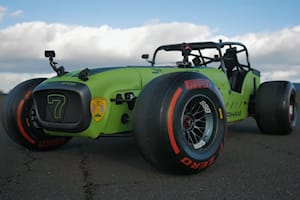Turns out, physics are a thing.
Formula 1 cars go really, really fast. So fast, that drivers train both their bodies and their minds for the majority of their lives in order to extract every last drop of speed out of these intimidating machines. There was a segment on Top Gear you might remember where Richard Hammond hopped in the driver's seat of Fernando Alonso's Renault F1 car. He could barely get the thing moving, and Richard is no novice at the wheel. Every aspect of these cars oozes speed, including the tires.
So, you'd think having that kind of grip on your car sounds lovely. Center-lock wheels mean super easy maintenance, and the grip levels mean you'll be the fastest guy or girl up your local piece of tarmac. Well, perhaps not, as Driven Media found out. In fact, they found out it's actually a really bad idea.
The reasoning here is simple. If you remember your Top Gear well enough, you'll know that at one point Richard says the hardest thing about driving an F1 car is the speed you have to go to get the aero to work with the rest of the car. Us humans simply can't manage it, but aliens like Sebastian Vettel do it easily. Aerodynamics help the tires work by pushing them into the road, and a Caterham Seven 270 has exactly zero aerodynamics to speak of. As a result, the tires are already outside their operating window.
Then there's the heat. If you've watched an F1 race before, you've seen the bags that fit over the tires, which help keep them up to temperature when not in use. Driven Media actually had a set to use on their Caterham. They didn't help much. The Caterham's 137 hp is barely enough to turn the tires, let alone spin them fast enough to generate the friction needed to keep them in their 212 degrees Fahrenheit operating window. Not to mention the custom center-lock adapters needed to make them fit. Host Scott Mansell said at one point the tires weren't even at 100 degrees.
Even if you had a so-called "F1 car for the road" like the Mercedes-AMG ONE, its 1,021 hp still wouldn't be enough to make the tires work on account of their massive size and the aerodynamics needed to get them working. That said, it's a hilariously cool thought experiment that certainly drew a lot of attention from onlookers. While the experiment ultimately proved unsuccessful, we'd love to see someone make it work. You'd just need someone to drive it (call us).









Join The Discussion